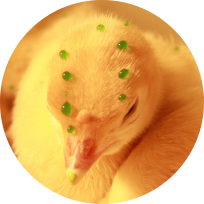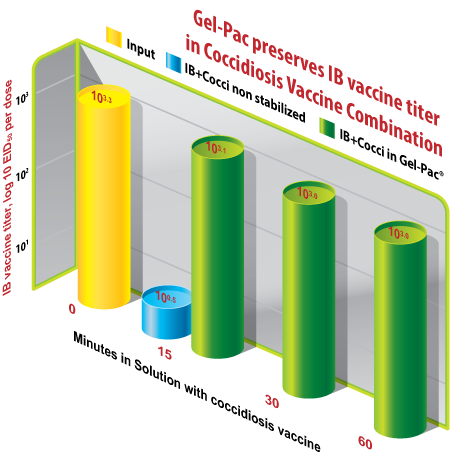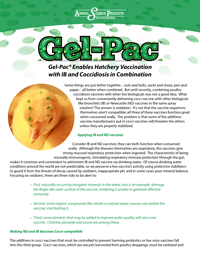
Gel-Pac® Enables Hatchery Vaccination with IB and Coccidiosis in Combination
 Some things are just better together…nuts and bolts, socks and shoes, pen and paper…all better when combined. But until recently, combining poultry coccidiosis vaccines with other live biologicals was not a good idea. But that has changed.
Some things are just better together…nuts and bolts, socks and shoes, pen and paper…all better when combined. But until recently, combining poultry coccidiosis vaccines with other live biologicals was not a good idea. But that has changed.
What kept us from conveniently delivering cocci vaccine with other biologicals like bronchitis (IB) or Newcastle (ND) vaccines in the same spray solution? The answer is oxidation. It’s not that the vaccine organisms themselves aren’t compatible; all three of these vaccines function great when consumed orally. The problem is that some of the additives vaccine manufacturers put in cocci vaccines will threaten others unless they are properly stabilized. ASP has developed an ideal solution.
Applying IB and ND Vaccines
Consider IB and ND vaccines; they can both function when consumed orally. Although the diseases themselves are respiratory, the vaccines give strong mucosal respiratory protection when ingested. The characteristic of being viscerally-immunogenic, stimulating respiratory immune protection through the gut, makes it common and convenient to administer IB and ND vaccine via drinking water. Of course, drinking water conditions around the world are not predictable. OUR SOLUTION preserves a live vaccine’s activity using protective stabilizers to guard it from the threats of decay caused by oxidizers, inappropriate pH, and, in some cases, poor mineral balance. Focusing on oxidizers, there are three risks to be alert to:
- First, naturally-occurring inorganic minerals in the water, iron for example, damage the finger-like outer surface of the vaccine, rendering it unable to generate effective immunity.
- Second, some organic compounds like nitrate in natural water sources can oxidize the vaccine, inactivating it.
- Third, some elements that may be added to improve water quality will ruin a live vaccine. Chlorine, peroxide and ozone are among these.
“Gel-Pac Reshapes the Future for Hatchery Vaccination.”
Making ND and IB Vaccines Cocci-Compatible
The additives in cocci vaccines that must be controlled to prevent harming probiotics or live virus vaccines fall into this third group. Cocci vaccines, which are oocysts harvested from poultry droppings, must be sanitized and preserved. Vaccine manufacturers traditionally do this by adding strong oxidizers. These include combinations of chlorine and ammonia, chromium compounds or others. Preservatives bottled with the cocci vaccines are potent enough to kill virtually all of a virus vaccine or probiotic that it comes in contact with, unless the vaccine or probiotic is effectively insulated.
With the development of modern, new generation vaccine stabilizers, cocci vaccines and live virus vaccines can be made entirely compatible with each other. No more soaking hatchlings. The incompatibility that forced hatcheries to soak the hatchlings with multiple water-based sprays can be negated. Probiotics that are intended to begin early pre-placement gut colonization are similar to IB and ND vaccines in this regard. Most hatcheries using probiotics prepare a separate solution to spray the beneficial bacteria. The additional liquid sprayed on the birds wets them, and is not presented in a way that is very ingestible. Gel-Pac, a powdered biological carrier that hatcheries mix with water to prepare an edible gel spray, also contains stabilizing power to insulate probiotics and live virus vaccines from potential threats in the water supply and has been used to protect biologicals when mixed with cocci vaccine. The defenses engineered into Gel-Pac give hatcheries the flexibility to conveniently spray multiple gut-active organisms, mixed with cocci vaccine, in one shot. Gel-Pac reshapes the future for hatchery vaccination. It insulates live vaccines and probiotics from the threat of cocci additives, enabling all the organisms to thrive in the gel spray, administered in an edible form so they can directly impact the gut, where they work best. The newfound freedom to mix and spray live vaccines such as IB with cocci vaccine has streamlined hatchery operations. There is no further need for multiple spray systems, one for cocci and the others for virus vaccines or probiotics. Although the semi-solid Gel-Pac spray is over 97% water, the birds remain dry in the hatchery box while preening and pecking a mixture of hydrated biologicals that are easy to see and easy to consume.
“No more soaking hatchlings.”
Beyond the convenience and labor savings, spraying edible cocci vaccine is recognized for producing stronger, more uniform cocci protection than aerosol sprays that are not easily or efficiently consumed by hatchlings. Cocci vaccine oocysts, like the other oral actives, work best when they are in the bird, not on the bird.
Testing Compatibility
To profile the stability of IB vaccine combined with cocci vaccine, Lasher Associates1 measured residual IB vaccine titers in cocci vaccine suspensions, mixed to label concentrations for hatchery spray. The IB titration used was the one USDA requires of vaccine manufacturers in Title 9, Code of Federal Regulations §113.329. Titrations were conducted using specific-pathogen-free (SPF) embryonate eggs2, replicated three times with separate dilutions for each titration. The Spearman-Karber method was used to calculate the EID50 per 0.2ml dose of vaccine.
 One ampule of a live commercially available IB vaccine, MILDVAC®– ARK3, (10,000 doses), was reconstituted in 10 ml of water and then diluted to a concentration of 5 doses per ml in sterile distilled (DI) water, in DI water containing 5 doses per ml LIVACOX® T4, and in a Gel-Pac solution containing 5 doses per ml LIVACOX T. The vaccine in water was titered immediately to quantify the starting IB potency as a positive control. The vaccine in the other two preparations was titered after 15 min to compare short-term stability, and the Gel-Pac suspension was tittered again after 30 and 60 min to assess the persistence of IB potency through a typical time in suspension (see figure).
One ampule of a live commercially available IB vaccine, MILDVAC®– ARK3, (10,000 doses), was reconstituted in 10 ml of water and then diluted to a concentration of 5 doses per ml in sterile distilled (DI) water, in DI water containing 5 doses per ml LIVACOX® T4, and in a Gel-Pac solution containing 5 doses per ml LIVACOX T. The vaccine in water was titered immediately to quantify the starting IB potency as a positive control. The vaccine in the other two preparations was titered after 15 min to compare short-term stability, and the Gel-Pac suspension was tittered again after 30 and 60 min to assess the persistence of IB potency through a typical time in suspension (see figure).
Results and Discussion
In an effort to bring greater efficiency to hatchery operations, many companies are attempting to combine two, or more, post-hatch spray-applied vaccines. By combining vaccines, the hatchlings are not subjected to multiple spray baths and the number of spray cabinets, with the attendant maintenance requirements, is reduced. Two of the commonly spray-applied vaccines are IB and coccidiosis. Of the coccidiosis vaccines, several are preserved in a solution of a potent preservative. When any of these are combined with a live IB vaccine, the titer of the latter is adversely affected (previous unpublished results). The goal of this study was to determine if Gel-Pac could be used to counter the effect of the coccidiosis vaccine and maintain IB vaccine potency.
As expected from previous titrations with combined vaccines, exposure to the coccidiosis vaccine alone decimated the IB vaccine virus before the earliest sample was titered. Within fewer than 15 minutes, the IB vaccine was significantly degraded, reducing the titer by at least 2.8 log in the presence of cocci vaccine unless stabilized with Gel-Pac. IB titer dropped from 103.3 EID50/0.2ml dose at the start to 100.5 EID50 in solution with a non-stabilized cocci vaccine (over 99% loss). At the same 15-minute time point, Gel-Pac protected the IB vaccine from this inactivation, preserving the titer at 103.1 EID50 ml and extending the protective activity beyond the end of the 60-minute span, longer than typically required for birds to consume the vaccine gel drops.
Shape-Changing
Globally, the poultry industry has watched its integrated companies push more of the responsibility for bird health onto their hatcheries. This is evident in practices such as in ovo vaccination, early pre-placement probiotic dosing, and in-hatchery brooding. Hatcheries work to maintain efficient operations while performing these ever-more-complex responsibilities. The increasing number of vaccinations and oral additives given in the hatchery has naturally lead veterinarians to look for ways to combine them into single applications. Atomized aerosol sprays containing these orally-active ingredients are not ideal because, beyond chilling birds with multiple sprays, the birds are not able to thoroughly consume the additives soaked into their wet feathers. Gel-Pac consolidates the oral additives and vaccines in a single convenient edible gel spray. Stabilizers allow the gel suspension to be safely prepared with hatchery tap water or well water without risking inactivation from cocci vaccines, and the uniformly suspended vaccines do not require constant agitation like liquid sprays do. Gel-Pac reshapes hatchery spray application. The door is now open to more options for oral-actives through more convenient and efficient combinations that are now truly better together.
References
1 V.S. Davis, Lasher Associates, Inc., Millsboro, DE, USA.
2 Charles River, North Franklin, CT, USA.
3 MILDVAC®– ARK, 10,000 doses per 10 ml vial, a registered trademark of Merck Animal Health. U.S. Corporate headquarters: 2 Gerald Farms, Madison, NJ, USA.
4 LIVACOX® T, 5,000 doses per 50 ml vial in a 1.0 % solution of chloramine B, a registered trademark of BIOPHARM, Research Institute of Biopharmacy and Veterinary Drugs, Pohori-Chotoun 90, 254 49 Jilove u Prahy, Czech Republic.
Gel-Pac® is a registered trademark of Animal Science Products, Inc., Nacogdoches, Texas, USA
Additional information and related articles on Gel-Pac®
SpecSheet | Spec Sheet Spanish | SDS | SDS Chinese | SDS Spanish Gel-Pac® new generation stabilizer aids in the administration of gel-delivered vaccines and probiotics for poultry. It is especially designed to prolong the viability and improve the effectiveness of reconstituted and diluted vaccines and probiotics in a gel that is convenient to prepare and easy for birds to consume.
RELATED ARTICLES:
Coccidia and IBV via Gel-Pac PDF
Gel-Pac Edible Gel for Vaccines PDF
Gel-Pac- The Ideal Gel Delivery System (booklet) ENGLISH | SPANISH
Gel-Pac New Generation Gel Delivery System with Stabilizer SELL SHEET
Gel-Pac® Permits Combining AviPro® Megan® Egg Salmonella Vaccine and Coccidiosis Vaccine for Hatchery Spray Application PDF | ARTICLE
Gel delivered vaccines, probiotics, and nutritional ingredients for poultry PDF | ARTICLE
Effects of Concentration and Temperature on the Viscosity of Gel-Pac PDF | ARTICLE
Gel-Pac Streamlines Newcastle Vaccine and Oral Additive Delivery PDF | ARTICLE
Gel-Pac Improving the titer of live infectious bronchitis vaccine for hatcheries PDF | SPANISH PDF | ARTICLE
Gel-Pac Efficacy of Gel-Pac Application for Poultry Coccidiosis Vaccination PDF | ARTICLE
Gel-Pac Enables Hatchery Vaccination with IB and Coccidiosis in Combination PDF | CHINESE PDF | ARTICLE
Gel-Pac Delivering Optimal Suspension PDF | SPANISH PDF| ARTICLE

